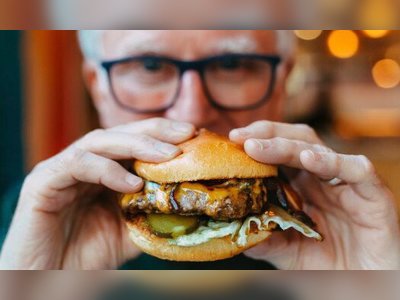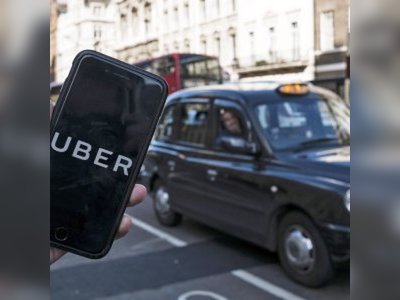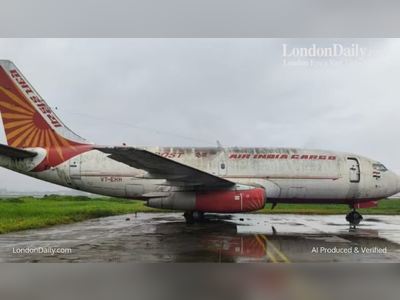Uber's new helicopter service is an expensive, time-consuming adventure
It cost me more than three times the money and an extra 15 minutes to fly to my local airport in an Uber helicopter than if I had taken the highway in an Uber X.
It also required multiple cab rides, squeezing into a tight space and overcoming a mild-to-moderate fear of flying while soaring alongside the Brooklyn Bridge.
On Thursday, the ride-hail company launched a premium helicopter service in New York City with the promise of 8-minute flights to nearby John F. Kennedy airport from downtown Manhattan. Uber intends to expand the service to more US cities and eventually - implausible as it may sound - offer this option to daily commuters who travel to and from neighboring suburbs.
In some ways, this ambitious service is a throwback to the premise Uber launched with a decade ago: offer a sleek and convenient transportation option so customers with too much disposable income can feel like high rollers — or "ballers" — while traveling. This time, the question is whether Uber can convince the Wall Street crowd near the helipad to upgrade from a car to a chopper.
During a test run earlier this week, it cost $205 for a one way Uber Copter trip to the airport — an experience that, start to finish, took me 55 minutes to complete. That fee included a 19-minute Uber X car ride from the Lower East Side 2.8 miles to the heliport, as well as a 5-minute trip to my final destination, the new TWA Hotel at JFK.
But for what's supposed to be an alternative to waiting in highway traffic, it still ends up being a headache. I could have arrived at the hotel in 40 minutes for $61 if I had ordered an Uber X ride from my original location south of Houston Street. That's saving almost $145 for a faster service. (Full disclosure: I tested the Uber Copter in the late morning; Uber typically offers it during peak afternoon commuting hours when flying over airport traffic really counts).
The launch comes at a time when the company could use some flashy product launches and positive headlines as it faces a daunting list of problems, including record losses, multiple rounds of layoffs, continued scrutiny over passenger safety, potentially existential regulatory threats and a stock price that is hovering near an all-time low.
As Uber expands its fleet of cars to scooters, bikes and now helicopters, it wants to give users more options for getting from one place to another. It envisions replacing helicopter trips with autonomous electric flying cars to make transportation faster and, in theory, safer. Under its new Uber Air division, it's working on a class of flying electric vehicles that can take off and land vertically. The company is expected to launch its first set of electric aircraft in Dallas, Los Angeles and Melbourne, Australia, in 2023.
"You can imagine Uber Copter is [as] kind of being the first version of that future product — that is fundamentally what we think of as multimodal," Eric Allison, head of Uber Elevate, said at the TWA Hotel following my Uber Copter flight. "Copter is not just about the air ride, but the overall journey. [We] can weave together our network of cars on the ground with the air vehicles; and in this case, the helicopter, so you can seamlessly transition from a car to the helicopter to a car to get you to the final destination. It's completely sequenced and figured out by our technology behind the scenes."
For now, Uber Copter is a narrow launch in one small slice of one big city. To get its helicopter business off the ground, it's relying on a third-party, charter company HeliFlite.
The 8-minute flight was the easiest part of the experience; check-in at the helipad was as simple as scanning a barcode and showing a driver's license. Ordering the Copter was easy, too. Users who have the highest status levels in Uber's reward program will see an option pop-up in the app when planning a trip involving Lower Manhattan.
On Thursday, the ride-hail company launched a premium helicopter service in New York City with the promise of 8-minute flights to nearby John F. Kennedy airport from downtown Manhattan. Uber intends to expand the service to more US cities and eventually - implausible as it may sound - offer this option to daily commuters who travel to and from neighboring suburbs.
In some ways, this ambitious service is a throwback to the premise Uber launched with a decade ago: offer a sleek and convenient transportation option so customers with too much disposable income can feel like high rollers — or "ballers" — while traveling. This time, the question is whether Uber can convince the Wall Street crowd near the helipad to upgrade from a car to a chopper.
During a test run earlier this week, it cost $205 for a one way Uber Copter trip to the airport — an experience that, start to finish, took me 55 minutes to complete. That fee included a 19-minute Uber X car ride from the Lower East Side 2.8 miles to the heliport, as well as a 5-minute trip to my final destination, the new TWA Hotel at JFK.
But for what's supposed to be an alternative to waiting in highway traffic, it still ends up being a headache. I could have arrived at the hotel in 40 minutes for $61 if I had ordered an Uber X ride from my original location south of Houston Street. That's saving almost $145 for a faster service. (Full disclosure: I tested the Uber Copter in the late morning; Uber typically offers it during peak afternoon commuting hours when flying over airport traffic really counts).
The launch comes at a time when the company could use some flashy product launches and positive headlines as it faces a daunting list of problems, including record losses, multiple rounds of layoffs, continued scrutiny over passenger safety, potentially existential regulatory threats and a stock price that is hovering near an all-time low.
As Uber expands its fleet of cars to scooters, bikes and now helicopters, it wants to give users more options for getting from one place to another. It envisions replacing helicopter trips with autonomous electric flying cars to make transportation faster and, in theory, safer. Under its new Uber Air division, it's working on a class of flying electric vehicles that can take off and land vertically. The company is expected to launch its first set of electric aircraft in Dallas, Los Angeles and Melbourne, Australia, in 2023.
"You can imagine Uber Copter is [as] kind of being the first version of that future product — that is fundamentally what we think of as multimodal," Eric Allison, head of Uber Elevate, said at the TWA Hotel following my Uber Copter flight. "Copter is not just about the air ride, but the overall journey. [We] can weave together our network of cars on the ground with the air vehicles; and in this case, the helicopter, so you can seamlessly transition from a car to the helicopter to a car to get you to the final destination. It's completely sequenced and figured out by our technology behind the scenes."
For now, Uber Copter is a narrow launch in one small slice of one big city. To get its helicopter business off the ground, it's relying on a third-party, charter company HeliFlite.
The 8-minute flight was the easiest part of the experience; check-in at the helipad was as simple as scanning a barcode and showing a driver's license. Ordering the Copter was easy, too. Users who have the highest status levels in Uber's reward program will see an option pop-up in the app when planning a trip involving Lower Manhattan.












